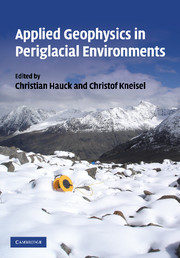Book contents
- Frontmatter
- Contents
- List of contributors
- Introduction
- Part I Geophysical methods
- Part II Case studies
- 5 Typology of vertical electrical soundings for permafrost/ground ice investigation in the forefields of small alpine glaciers
- 6 ERT imaging for frozen ground detection
- 7 Electrical resistivity values of frozen soil from VES and TEM field observations and laboratory experiments
- 8 Results of geophysical surveys on Kasprowy Wierch, the Tatra Mountains, Poland
- 9 Reassessment of DC resistivity in rock glaciers by comparing with P-wave velocity: a case study in the Swiss Alps
- 10 Quantifying the ice content in low-altitude scree slopes using geophysical methods
- 11 The use of GPR in determining talus thickness and talus structure
- 12 GPR soundings of rock glaciers on Svalbard
- 13 Arctic glaciers and ground-penetrating radar. Case study: Stagnation Glacier, Bylot Island, Canada
- 14 Mapping of subglacial topography using GPR for determining subglacial hydraulic conditions
- 15 Snow measurements using GPR: example from Amundsenisen, Svalbard
- 16 Mapping frazil ice conditions in rivers using ground penetrating radar
- Appendix: Tables of geophysical parameters for periglacial environments
- Index
- Plate section
- References
6 - ERT imaging for frozen ground detection
Published online by Cambridge University Press: 22 August 2009
- Frontmatter
- Contents
- List of contributors
- Introduction
- Part I Geophysical methods
- Part II Case studies
- 5 Typology of vertical electrical soundings for permafrost/ground ice investigation in the forefields of small alpine glaciers
- 6 ERT imaging for frozen ground detection
- 7 Electrical resistivity values of frozen soil from VES and TEM field observations and laboratory experiments
- 8 Results of geophysical surveys on Kasprowy Wierch, the Tatra Mountains, Poland
- 9 Reassessment of DC resistivity in rock glaciers by comparing with P-wave velocity: a case study in the Swiss Alps
- 10 Quantifying the ice content in low-altitude scree slopes using geophysical methods
- 11 The use of GPR in determining talus thickness and talus structure
- 12 GPR soundings of rock glaciers on Svalbard
- 13 Arctic glaciers and ground-penetrating radar. Case study: Stagnation Glacier, Bylot Island, Canada
- 14 Mapping of subglacial topography using GPR for determining subglacial hydraulic conditions
- 15 Snow measurements using GPR: example from Amundsenisen, Svalbard
- 16 Mapping frazil ice conditions in rivers using ground penetrating radar
- Appendix: Tables of geophysical parameters for periglacial environments
- Index
- Plate section
- References
Summary
Introduction
Measurements of direct current (DC) resistivity are useful for detecting frozen ground, because the resistivity values significantly increase in accordance with water's phase change from liquid to solid. Conventional vertical electrical soundings (VES) involve the placement of four-electrode arrays and have been the most commonly used geophysical technique for identifying the occurrence of frozen ground (see Chapter 5). Problems have arisen from the necessary assumption of a horizontally bedded subsurface structure for standard VES interpretation. This situation is further complicated by concave and convex surfaces in topography and significant lateral variation in subsurface water conditions even over small areas, especially in mid-latitude mountainous areas and discontinuous permafrost zones. Therefore, interpretation of data sets obtained by VES alone often remains ambiguous.
As described in detail in Chapter 1, ERT is the hybrid of vertical and horizontal resistivity soundings in which a large number of four-electrode combinations (so-called quadripoles) are measured. This technique two-dimensionally delineates subsurface electrical structures and has recently been recognised as an effective method for investigating frozen ground under complicated topography and/or subsurface structures. In the following case studies ERT was applied in discontinuous and sporadic permafrost areas in order to delineate and characterise frozen ground in the Asian mountain permafrost regions of the Daisetsu Mountains, northern Japan, the Kanchenjunga Himal, eastern Nepal, and the Shijir valley of northeastern Mongolia. On the basis of these research experiences, this note describes practical issues for applying ERT imaging in mountain permafrost regions.
- Type
- Chapter
- Information
- Applied Geophysics in Periglacial Environments , pp. 109 - 117Publisher: Cambridge University PressPrint publication year: 2008
References
- 5
- Cited by



